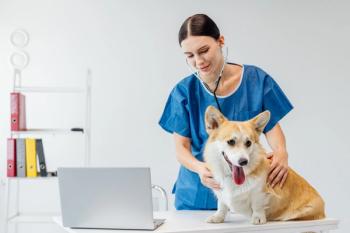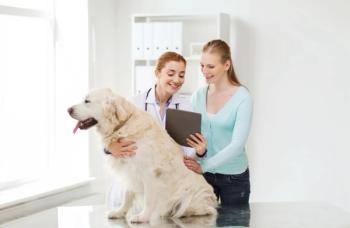
July 4th pet safety: Lakes, boating, and fireworks
Blue-green algae is found in still bodies of water and may pose a lethal risk to cats and dogs
With the Fourth of July approaching, keeping clients informed of the dangers dogs face during this holiday season is important. With many people celebrating the holiday near bodies of water, Texas A&M University College of Veterinary Medicine and Biomedical Sciences (VMBS) recently shared precautions pet owners should take to keep their dogs safe if bringing their animal companion along to a day on a lake.1
Swimming? Proceed with caution
Assessing the quality of the water is a must before allowing dogs to access it, as large bodies of water may contain parasites and other hazards to dogs, according to Texas A&M.1 “I would try to discourage pets from drinking lake water as much as possible, as parasites, trash, contaminants and even certain algae can be in the water,” Erin Ray, DVM, clinical assistant professor at VMBS, said in a university report.1 “Researching the area, checking social media, or even calling the area officials to inquire about current conditions is always a good idea.
According to Ray, blue-green algae—a cyanobacteria that is found in stationary bodies of water like ponds, lakes, or rivers—produce toxins that may affect the liver and neurological system, posing a lethal risk to dogs and cats.1,2 Because this bacterium is difficult to spot with the naked eye, even clear bodies of water pose a risk.1,2
“Dogs get infected by drinking or swimming in affected waters. When anchoring for a swim break (on a boat), it is best to avoid stagnant water and water with obvious algae ‘blooms’ on the water surface,” said Ray.1 Initial clinical signs of infection from this cyanobacterium include convulsions and collapse and can develop immediately after the animal leaves the water.2
If bringing pets along to a boat trip, Texas A&M also advises owners to pack “pet care essentials.” These include1:
- Dog food
- A water bowl and fresh water
- Life jacket
- Paw protection
- Gentle shampoo for dogs, such as those that are soap-free or oatmeal-based
- Kennel with comfort toys
- Chronic medications if needed
Additional safety tips, in and out of the water
When operating a boat, exercise caution to prevent pets from falling overboard and being pulled underwater. To help keep pets safe, avoid sharp turns and high speeds. Additionally, introducing the dog to a life jacket ahead of the trip can help them feel more comfortable and ensure the life jacket fits properly. Ray recommends dogs wear a life jacket when on or near water to prevent drowning.1
Additional risks to be aware of include1:
- Burning paw pads on asphalt
- Aggressive animals inside and outside of the water
- Boat or vehicle injuries
Human foods and beverages such as hot dogs, chips, alcohol, and chocolate should be kept out of reach of pets. Caregivers should also remain vigilant of pets consuming fireworks or trash.1
Additionally, prolonged exposure to the sun and high temperatures pose a risk of dehydration and hyperthermia. “In the middle of summer it gets very hot, putting dogs at risk for heat stroke—especially brachycephalic breeds and dogs with thick/long coats—which is life-threatening and caused by not having access to ample clean, fresh water, shade or air-conditioning to cool down in,” Ray said.1
Signs of hyperthermia include excessive panting, excessive water intake, seizures, lethargy, collapse, and blue-colored tongue or gums.1 Ray recommends avoiding dogs play for prolonged periods of time during the hottest times of the day without shade or water.1
Related:
Fireworks
Pets who are not in a safe space during firework displays may become stressed or anxious and are at higher risk of running away or becoming lost. According to a data analysis from the nonprofit organization Shelter Animals Count, the number of stray dog intakes at shelters consistently increases in the days surrounding July 4th.3
Precautionary steps caregivers can take include planning ahead to secure pets in a safe, quiet place ahead of, during, and after the firework displays. According to Ray, white noise or reggae music may help calm pets.
For dogs on a boat trip, anchoring the boat farther from the fireworks can help reduce their stress. “Owners can try to calm down their pets physically with petting, calm voices and a loving hold,” Ray added.1 If firework-related anxiety is known prior to boat travel, a veterinary consultation is recommended to discuss potential medications that may help manage the pet’s stress levels.
References
- Your pet’s lake day survival guide for the Fourth of July. Texas A&M University College of Veterinary Medicine and Biomedical Sciences. June 26, 2025. Accessed July 1, 2025.
https://stories.tamu.edu/news/2025/06/26/your-pets-lake-day-survival-guide-for-the-fourth-of-july/ - Springtime bliss: Keeping your pets safe from poisonous plants. Texas A&M University College of Veterinary Medicine and Biomedical Sciences. March 14, 2024. Accessed July 1, 2025.
https://vetmed.tamu.edu/news/pet-talk/keeping-your-pets-safe-from-poisonous-plants/?_gl=1*14r0p84*_ga*MTAxMDQ5Nzg3MS4xNzQ0MjkyNzky*_ga_3LYM4WJM04*czE3NTEzOTAwODQkbzExJGcwJHQxNzUxMzkwMzg4JGo1NCRsMCRoMA . - Stray dog intakes spike after July 4th, new data from Shelter Animals Count confirms—Shelter Animals Count. News release. Shelter Animals Count. June 23, 2025. Accessed July 1, 2025.
https://www.shelteranimalscount.org/stray-dog-intakes-spike-after-july-4th-new-data-from-shelter-animals-count-confirms/#:~:text=Analysis%2C%20SAC%20News-,Stray%20Dog%20Intakes%20Spike%20After%20July%204th%2C%20New%20Data%20from,seasonal%20spike%20and%20respond%20effectively .
Newsletter
From exam room tips to practice management insights, get trusted veterinary news delivered straight to your inbox—subscribe to dvm360.




